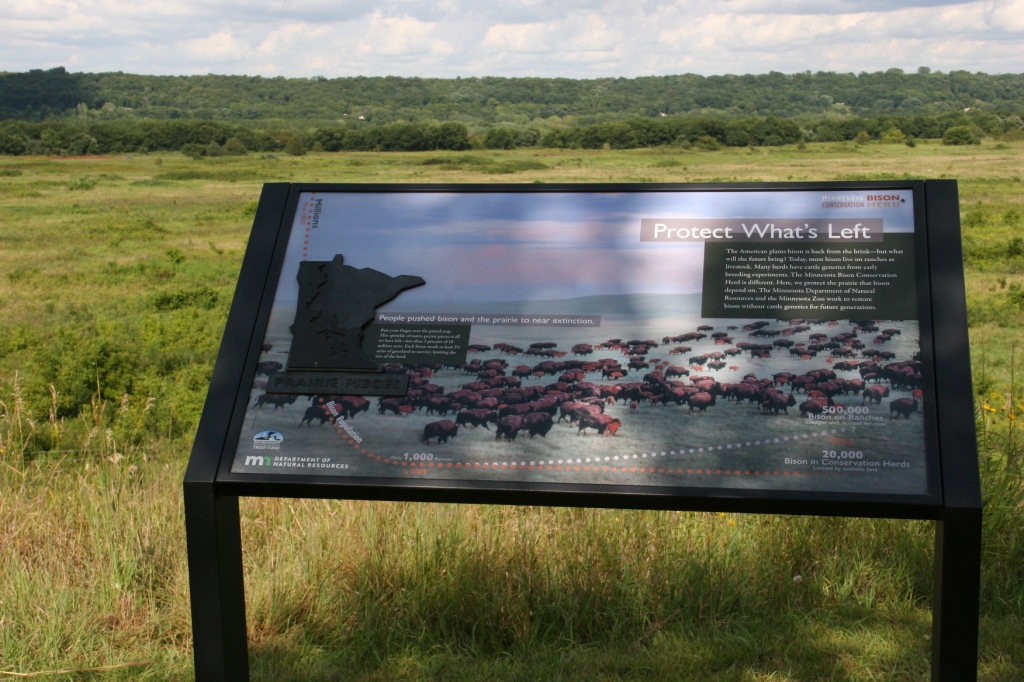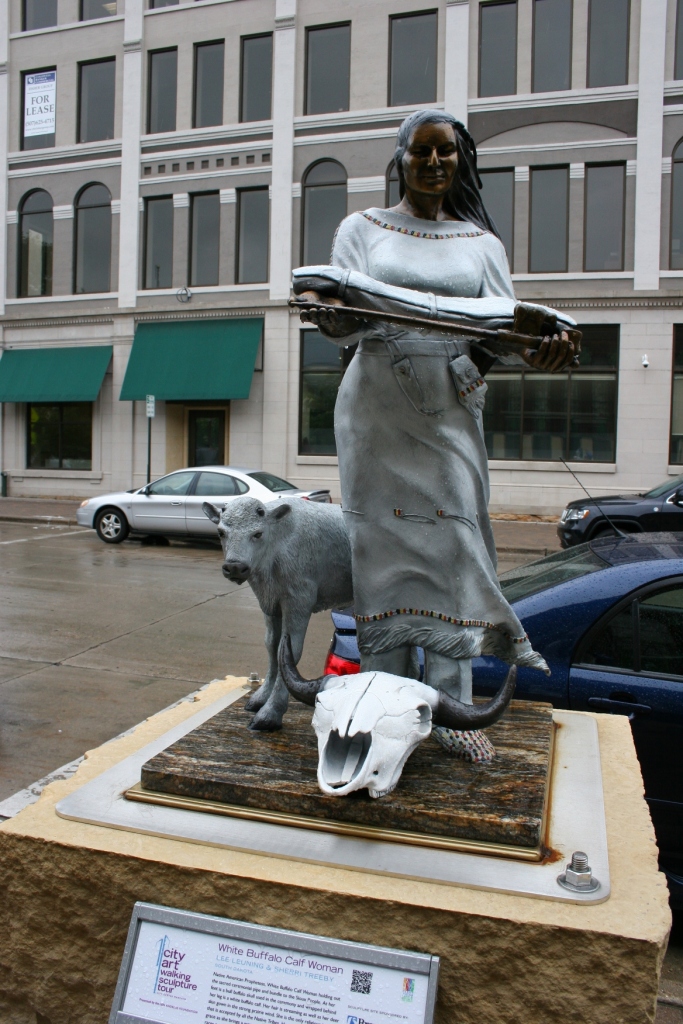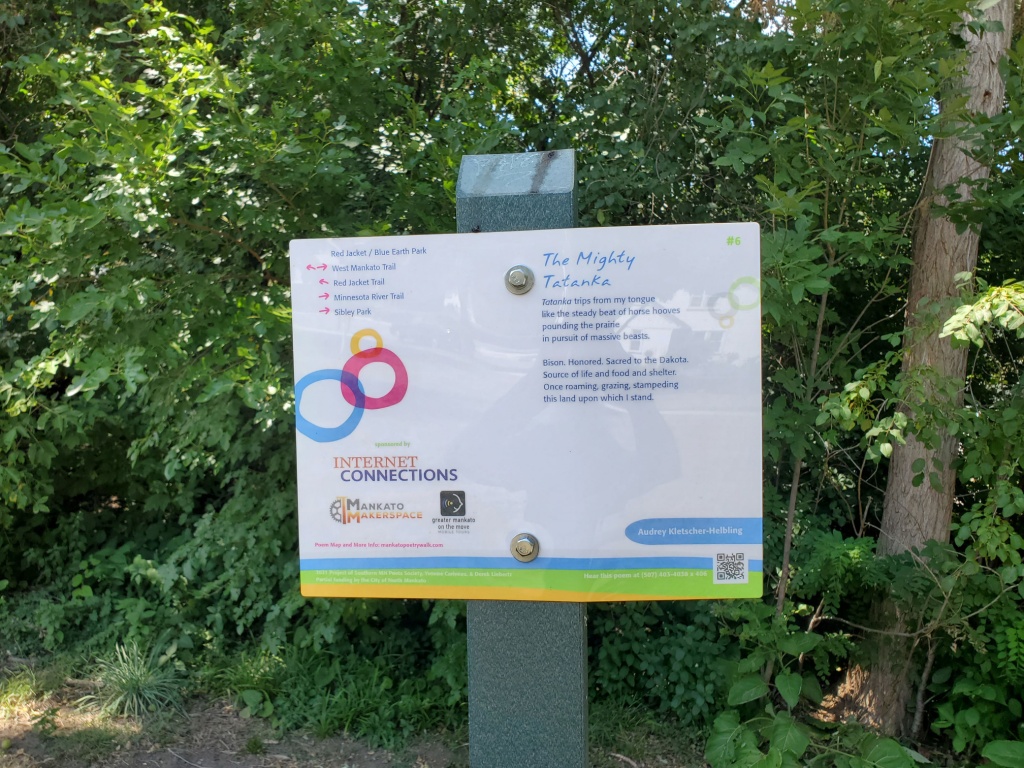
THEY ARE MASSIVE BEASTS, once roaming the American Great Plains by the millions. They are bison, also called buffalo, today numbering some 370,000 in North America. Most are raised as livestock. But some 31,000, or eight percent, are part of conservation herds, including right here in Minnesota. Such herds are designed to protect wild bison and preserve their genetic diversity.

An upcoming documentary, “The American Buffalo—A Story of Resilience” by awarding-winning filmmaker Ken Burns, and my own recently posted poem about bison prompted my renewed interest in this animal. Burns’ 4-hour film airs in two parts, at 7 pm on Monday, October 16, and on Tuesday, October 17, on PBS. His documentary traces the history of bison, their importance in Native peoples’ lives and culture, their near extinction, and efforts to bring them back.

My connection to bison began decades ago with childhood visits to Ramsey Park (in Redwood Falls), now also more appropriately called Cansayapi Park. Cansayapi in the Dakota language means “where they marked the trees red,” the traditional Minnesota River valley homeland of the Dakota. The Lower Sioux Indian Community is located near nearby Morton with an enrolled membership of 930 of the Mdewakanton Band of the Dakota.

Given the region’s rich Native heritage, the presence of a small group of bison in the Ramsey Park Zoo seems fitting. I recall rushing to see the buffalo there, both excited and intimidated by their massive hulk. Today I’m not so much afraid as respectful of their size and their importance in Indigenous Peoples’ culture.

One need only look back in history to see how invaluable bison were to these original inhabitants of the prairie, the plains. Bison provided food, shelter, clothing and more to Indigenous Peoples. They also held spiritual and cultural significance. Bison were considered kin, respected by those who respected Mother Earth.
And then the white man came in the 1800s, overtaking the land, nearly driving bison to extinction as they hunted and slaughtered the animal primarily for their hides.

And so the story of bison is not only one of past atrocities in American history, but also one of personal history for me with those fenced bison in Minnesota’s largest municipal park, known as “The Little Yellowstone of Minnesota” for its beautiful natural topography seemingly like Yellowstone National Park. Yellowstone, the one in Wyoming, is home to nearly 6,000 bison.

In my youth, I didn’t understand the importance of bison in Native culture. I simply delighted in seeing them in the zoo at then Alexander Ramsey Park in my native Redwood County. Neither did I recognize how offensive the name of the park I loved as a child—Alexander Ramsey Park. Alexander Ramsey served as our first territorial governor and then as the second state governor of Minnesota during the US-Dakota War of 1862. He offered a bounty to anyone who killed a Dakota person and called for Indigenous Peoples to be driven out of Minnesota.

With that backstory and an understanding of a period in Minnesota history marked by hatred and injustices, I paid homage to bison in a poem now gracing a sign in Mankato. Mahkato, a Dakota word which means “blue earth,” was the site of the largest mass execution in the United States on December 26, 1862. Thirty-eight Dakota, sentenced to death in sham trials for their roles in the US-Dakota War, were hung in Mankato.
I wanted to honor the original inhabitants of Mahkato, the bison, the Native culture, the land. And so I wrote “The Mighty Tatanka,” using the Dakota word for bison. My poem was selected for inclusion in the Mankato Poetry Walk & Ride and is posted on a sign in West Mankato.
The Mighty Tatanka
Tatanka trips from my tongue
like the steady beat of horse hooves
pounding the prairie
in pursuit of massive beasts.
Bison. Honored. Sacred to the Dakota.
Source of life and food and shelter.
Once roaming, grazing, stampeding
this land upon which I stand.
While my poem is succinct, limited by wordage requirements in the poetry competition, I’d like to think “The Mighty Tatanka” is powerful. It holds not only the rhythm of carefully selected words, but a story. A story of bison, of Indigenous Peoples, of a way of life, of a culture. It holds, too, honor for the land and of those who first inhabited, and respected, it.
#
FYI: My poem is posted on a sign along the West Mankato Trail near the intersection of Owatonna Street and Blue Earth and Sylvia Streets in West Mankato. You can listen to me read my poem by calling 507-403-4038 and entering 406.

To see Minnesota Bison Conservation Herd bison in Minnesota, visit Minneopa State Park near Mankato, Blue Mounds State Park near Luverne, the Minnesota Zoological Garden, Oxbow Park & Zollman Zoo by Byron, and Spring Lake Park Reserve Bison Prairie in Dakota County.
© Copyright 2023 Audrey Kletscher Helbling



Your honoring of the Native Americans and buffalo is a lovely tribute. Congratulations on your poem and its placement. 🙂 ❤ ❤
Thank you on both counts, Penny. I appreciate your support.
Great article and photos Audrey! Wopida tanka.
Thank you kindly, John. It’s good to hear from you. 🙂
The American Bison is a noble (and tasty) beast that was necessary for sustenance of the Native Americans, From my understanding, there were two major herds in North America. Evidence of their presence is seen all over the United States. The last time one herd passed nearby San Antonio, was the day the Alamo fell in 1836. Residents East of San Antonio described the thunder and shaking of lasting for hours. New Mexico has hundreds of depressions in the ground caused by these herds South of Rabbit Ear Mountain. Camp Pendleton, California even has its own small herd. People should keep in mind these are powerful animals and while they seem tame, they are not. The Buffalo is to the Native American what the Long Horn Cow is to the Cowboy. Both these animals are impressive far beyond the present day perspective. It is a sad note in history to find that the demise of the Bison was planned to subdue the Native Americans. I think it also should be kept in mind that a rancher took a small number of these creatures lest they become extinct. This small herd ensured to continuation of the line of Bison we see today
I always appreciate your historical additions to my posts, Gunny. You are definitely right about buffalo hunting by white men also being a means to drive Native Peoples out, or to “subdue” them as you state.
It’s interesting to read about the bison in Minnesota. I have not seen the limestone sculpture in Mankato…I’d like to sometime.
Thanks for sharing your poem, and for alerting us to the Ken Burns special.
I recall you writing about the bison herd in Dakota County. I am looking forward to the Ken Burns’ documentary.
your poem in a lovely part of this beautiful place and honors the majestic animals and original people who lived and thrived there. you honor them with your words and sharing of their stories.
Thank you, Beth. We each do whatever we can to honor and inform, while showing respect, right?
Yes
Congratulations on another milestone in your writing career. Bison are pretty amazing , aren’t they?
Thank you for appreciating my poem, Beth Ann. Yes, bison are quite the amazing creatures for so many reasons.